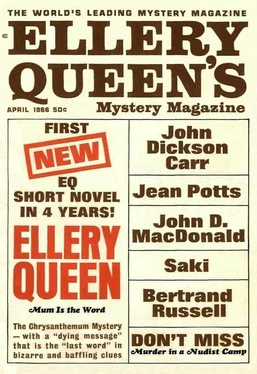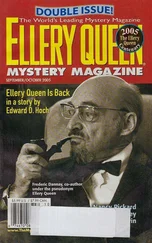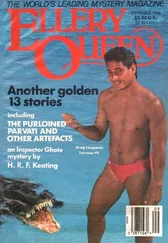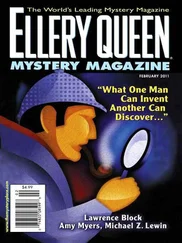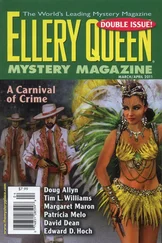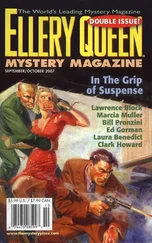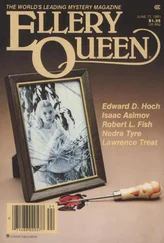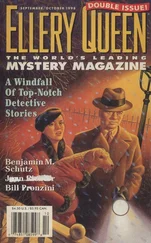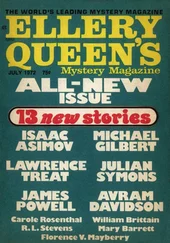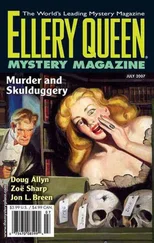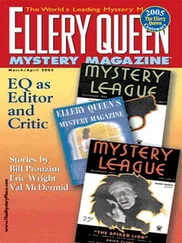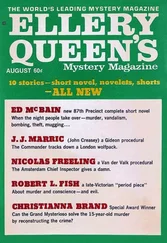Эллери Куин - Ellery Queen’s Mystery Magazine. Vol. 47, No. 4. Whole No. 269, April 1966
Здесь есть возможность читать онлайн «Эллери Куин - Ellery Queen’s Mystery Magazine. Vol. 47, No. 4. Whole No. 269, April 1966» весь текст электронной книги совершенно бесплатно (целиком полную версию без сокращений). В некоторых случаях можно слушать аудио, скачать через торрент в формате fb2 и присутствует краткое содержание. Город: New York, Год выпуска: 1966, Издательство: Davis Publications, Жанр: Детектив, на английском языке. Описание произведения, (предисловие) а так же отзывы посетителей доступны на портале библиотеки ЛибКат.
- Название:Ellery Queen’s Mystery Magazine. Vol. 47, No. 4. Whole No. 269, April 1966
- Автор:
- Издательство:Davis Publications
- Жанр:
- Год:1966
- Город:New York
- ISBN:нет данных
- Рейтинг книги:4 / 5. Голосов: 1
-
Избранное:Добавить в избранное
- Отзывы:
-
Ваша оценка:
- 80
- 1
- 2
- 3
- 4
- 5
Ellery Queen’s Mystery Magazine. Vol. 47, No. 4. Whole No. 269, April 1966: краткое содержание, описание и аннотация
Предлагаем к чтению аннотацию, описание, краткое содержание или предисловие (зависит от того, что написал сам автор книги «Ellery Queen’s Mystery Magazine. Vol. 47, No. 4. Whole No. 269, April 1966»). Если вы не нашли необходимую информацию о книге — напишите в комментариях, мы постараемся отыскать её.
Ellery Queen’s Mystery Magazine. Vol. 47, No. 4. Whole No. 269, April 1966 — читать онлайн бесплатно полную книгу (весь текст) целиком
Ниже представлен текст книги, разбитый по страницам. Система сохранения места последней прочитанной страницы, позволяет с удобством читать онлайн бесплатно книгу «Ellery Queen’s Mystery Magazine. Vol. 47, No. 4. Whole No. 269, April 1966», без необходимости каждый раз заново искать на чём Вы остановились. Поставьте закладку, и сможете в любой момент перейти на страницу, на которой закончили чтение.
Интервал:
Закладка:
“A woman got murdered on the East Side,” O’Malley said. “It looks like it was a funny kind of case. She was about sixty years old and everybody in the neighborhood knew who she was, but there didn’t nobody know anything about her.
“The name they knew her by was Miss Dubois, but it turns out she had several different names. There was some addresses in her place, and they found one guy that told ’em things about her but it don’t point to why she should get killed.”
“What have you got to work on?” I inquired.
“Not much. My idea is this gets marked ‘Unsolved.’ Well, still I got to run around and look at it.”
We looked at the woman. She must have been very pretty in her youth. She had been strangled with a woman’s belt. Her clothes were of the best quality and the belt matched the dress.
“What’s this?” O’Malley asked.
He showed me some pinholes in the bosom of her slip.
“She seems to have worn a brooch,” I said.
“Yeah? On her underclothes?”
He took a pattern of the pinholes on a piece of paper.
“We’ll see the guy that told the cops them things,” he said.
The man’s name was Collingham. We found him in a small but impressive office in the Wall Street neighborhood. He was a distinguished-looking man of about fifty.
“How was it about that lady that got knocked off?” O’Malley asked.
“I’ve already told the police all I know, but I don’t mind repeating it. She was a sort of pensioner of mine. Years ago this woman was a motion-picture actress. Her screen name was Vera Cain. I worshiped her on the screen, but at that time I didn’t meet her. A few years ago I encountered her on the street. Of course, she was greatly changed, but in spite of that I recognized her and introduced myself, and I learned that she was in want.
“In memory, as you might say, of my youth, I got her address and sent her a small check. A man like myself, who has made a great deal of money, picks up a certain number of people who are dependent on him. After that, each month I sent her a small check.”
“I guess you seen her pretty often after you found out where she lived.”
“No, I never saw her except that one time on the street. She wrote me a note of thanks each month but I didn’t keep them.”
“You send her a check this month?”
“Yes, on the first, as I always did if I remembered it.”
“That check been cashed?”
“Yes, it was cashed.”
“You don’t seem to feel very bad because the dame got bumped off.”
“There’s no reason why I should. She was no longer the girl whom I remembered.”
“Okay.”
“That’s a nice fellow, O’Malley,” I remarked after we had left him.
“He talks like it.”
We went to see her home where she was killed. It was a poor neighborhood. There were pushcarts along the curb and a street filled with children; people sat on crowded doorsteps. A cop let us into her apartment. It was luxurious. The furniture was of expensive make, the bed things were lace and silk.
“Well, this is a surprise, O’Malley!” I exclaimed. “Collingham can’t have known she was well off. Why did she live in this neighborhood?”
“I guess she wanted to. How was this?” he asked the cop.
“They don’t know much. The guy came in the window.”
He showed us. A rear window had been forced open. The window opened on a court. There was a fire escape under the windows of the next apartment.
We examined the place carefully. Dresser drawers had been pulled out and the things scattered about; the cops hadn’t done that. The closets were filled with expensive clothes. In one closet there was a trunk. The police had searched it but we went through its contents. There were souvenirs from hotels and steamship lines and summer and winter resorts.
“This dame was a gay one in her time,” O’Malley remarked.
“She must have been.”
“It’s my idea it will turn out she was some kind of crook. What time did the medical guy say this dame got bumped?” he asked the cop.
“About four o’clock yesterday afternoon.”
“What become of that address book they found?”
“They got it at the station house.”
O’Malley telephoned the station house to send us the address book.
“What do you make of it so far?” I asked.
“I got no ideas.”
“I have,” I said.
“Yeah?”
“This is the kind of case,” I said, “where the police go wrong because they find too many things that might be clues. They aren’t really clues, and so they waste time on things that get them nowhere. Those things have nothing to do with her being murdered.”
“Go on — you’re doing swell. What is it that has got to do with it?”
“The way she lived and the way she dressed. In this kind of neighborhood she was simply courting robbery. Collingham had just sent her some money; whether she kept her money in her apartment or not, people around here must have believed she did. Anyway, the murderer believed it. It’s plain how he got in. He came up or down the fire escape and reached across and forced the window open and stepped from the fire escape onto the sill.”
“You’re good. Who was the guy?”
“Of course I don’t know that, but it’s plain he lives in this neighborhood. The killing took place in midafternoon when other windows were open on this court and someone may have seen him.”
“Well, we can find that out.”
We went around and asked the people whose windows opened on the court. The window directly across belonged to a photographer. He hadn’t seen anything, but he said his partner might have; the partner wasn’t there. The other people hadn’t seen anything.
When we got back to the apartment a man was there with the address book. There wasn’t much in it — a few telephone numbers and a few street numbers. O’Malley called one of the phone numbers.
“Is Freeman there?” he asked. Somebody answered. “Ain’t this the Sheffield Hotel?” he inquired.
“What is it?” I asked.
“He says it’s a meat market.” “Who’s Freeman?” I asked.
“That ain’t no guy. I just made that up to find out whose phone it was.”
He tried the other phone numbers the same way, but they all turned out to be tradesmen’s places.
“Well, nothing in that,” he said. “I guess we won’t find nothing in these addresses either.”
One of the addresses was Collingham’s. We went around to all the others. The first one turned out to be a beauty shop.
They knew Miss Dubois as a customer, but of course they had no idea who’d killed her. She was known the same way at most of the other addresses. At two places we couldn’t find anyone who’d ever heard of her. One of these places wasn’t really an address at all — the street number came in Central Park.
“Well, that ends that,” I stated.
“Why, no,” O’Malley said. “It ends them places where they knew about her, but we got two they don’t. Why would she have a number that comes in the park? I think that looks funny. I’m figuring this dead dame was a crook, and crooks got ways of writing things so that whoever finds ’em won’t read ’em right. It might be we got that kind of business here. One way is, they write the numbers backwards.”
I studied the two addresses. One said 236 Cathedral Parkway and the other one, 345 Columbus Avenue. On the same page it said “3F.” We looked up 632 Cathedral Parkway and 543 Columbus, but it got us nothing.
“There’s still another way they do,” O’Malley said. “If they write two addresses, one gives the right number but the other one gives the street.”
There was no such number as 345 Cathedral Parkway, so we tried 236 Columbus. A good-looking young man about 22 years old opened the door of apartment 3F.
Читать дальшеИнтервал:
Закладка:
Похожие книги на «Ellery Queen’s Mystery Magazine. Vol. 47, No. 4. Whole No. 269, April 1966»
Представляем Вашему вниманию похожие книги на «Ellery Queen’s Mystery Magazine. Vol. 47, No. 4. Whole No. 269, April 1966» списком для выбора. Мы отобрали схожую по названию и смыслу литературу в надежде предоставить читателям больше вариантов отыскать новые, интересные, ещё непрочитанные произведения.
Обсуждение, отзывы о книге «Ellery Queen’s Mystery Magazine. Vol. 47, No. 4. Whole No. 269, April 1966» и просто собственные мнения читателей. Оставьте ваши комментарии, напишите, что Вы думаете о произведении, его смысле или главных героях. Укажите что конкретно понравилось, а что нет, и почему Вы так считаете.
